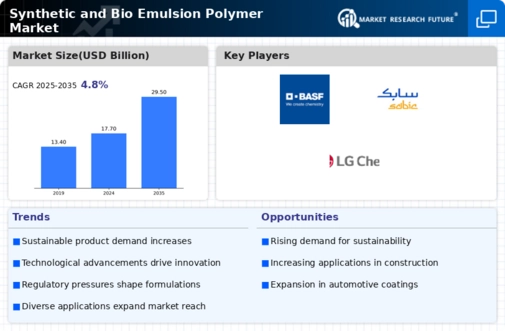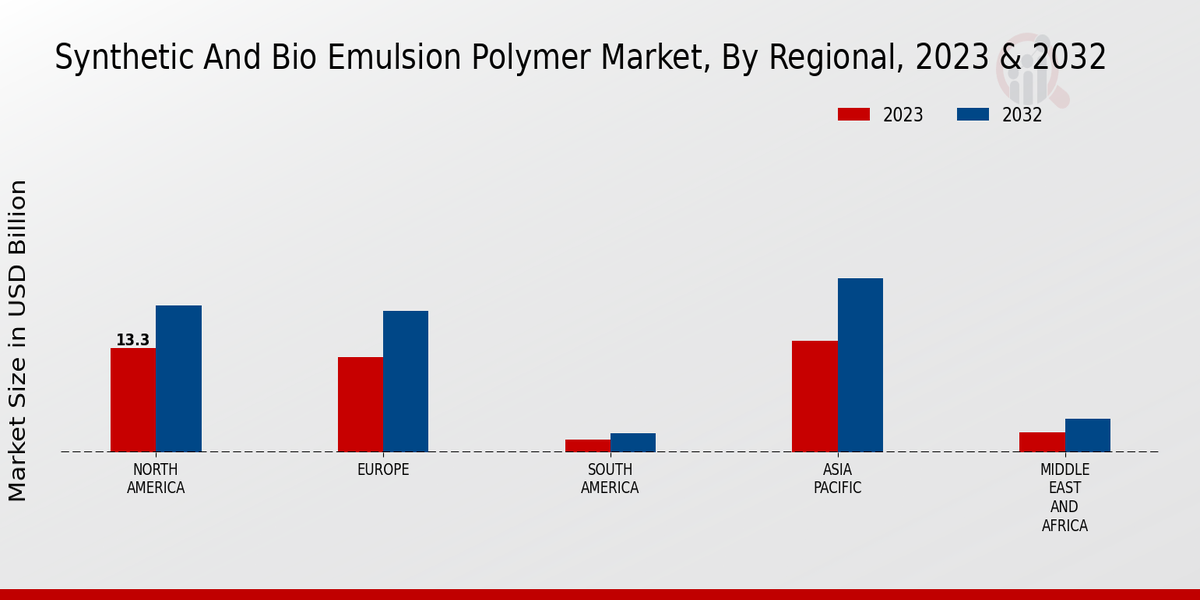Market Growth Projections
Growth in Construction Activities
The Global Synthetic and Bio Emulsion Polymer Market Industry is significantly influenced by the expansion of construction activities worldwide. As urbanization continues to rise, particularly in developing nations, the need for advanced materials that enhance durability and performance becomes paramount. Emulsion polymers are widely utilized in paints, adhesives, and coatings, which are essential for modern construction. The market is projected to reach 29.5 USD Billion by 2035, reflecting a compound annual growth rate of 4.75% from 2025 to 2035. This growth underscores the critical role of synthetic and bio emulsion polymers in meeting the demands of contemporary construction practices.
Rising Demand for Eco-Friendly Products
The Global Synthetic and Bio Emulsion Polymer Market Industry experiences a notable shift towards eco-friendly products, driven by increasing consumer awareness regarding environmental sustainability. This trend is particularly evident in the construction and automotive sectors, where bio-based polymers are gaining traction as alternatives to traditional synthetic options. The demand for sustainable solutions is expected to contribute to the market's growth, with projections indicating a market value of 17.7 USD Billion in 2024. As industries seek to reduce their carbon footprint, the adoption of bio emulsion polymers is likely to accelerate, fostering innovation and development in this segment.
Regulatory Support for Sustainable Practices
Regulatory frameworks promoting sustainable practices significantly impact the Global Synthetic and Bio Emulsion Polymer Market Industry. Governments worldwide are implementing stringent regulations aimed at reducing environmental impact, which encourages manufacturers to adopt greener alternatives. This regulatory support fosters the development and adoption of bio emulsion polymers, which are perceived as more environmentally friendly compared to their synthetic counterparts. As industries comply with these regulations, the demand for bio-based solutions is likely to rise, contributing to the overall market growth. The alignment of regulatory policies with market trends suggests a favorable environment for the expansion of sustainable polymer solutions.
Technological Advancements in Polymer Production
Technological advancements play a crucial role in shaping the Global Synthetic and Bio Emulsion Polymer Market Industry. Innovations in polymerization techniques and the development of new formulations enhance the performance characteristics of emulsion polymers, making them more appealing to various industries. For instance, advancements in water-based emulsions have led to improved environmental profiles and application versatility. These innovations not only cater to the growing demand for high-performance materials but also align with sustainability goals. As a result, the market is poised for growth, with an anticipated increase in investment in research and development to further enhance product offerings.
Increasing Applications Across Diverse Industries
The versatility of synthetic and bio emulsion polymers leads to their increasing applications across diverse industries, thereby driving the Global Synthetic and Bio Emulsion Polymer Market Industry. These polymers are utilized in sectors such as automotive, textiles, and packaging, where their properties enhance product performance and durability. For example, in the automotive industry, emulsion polymers are used in coatings and adhesives that improve vehicle aesthetics and longevity. This broad applicability not only supports market growth but also encourages innovation in product development. As industries continue to explore new applications, the market is expected to witness sustained demand and expansion.





